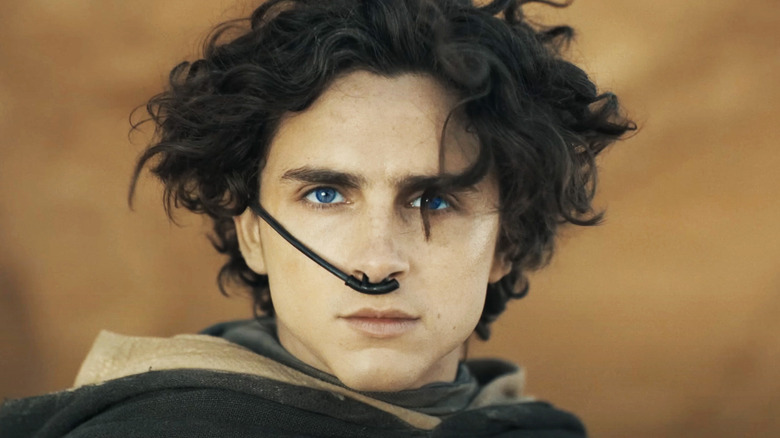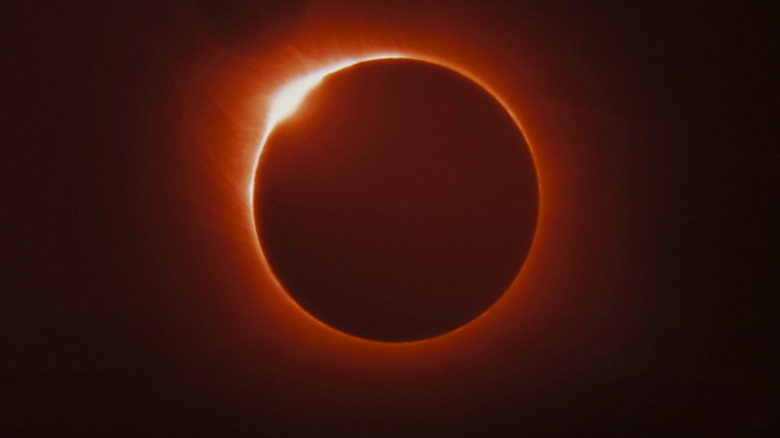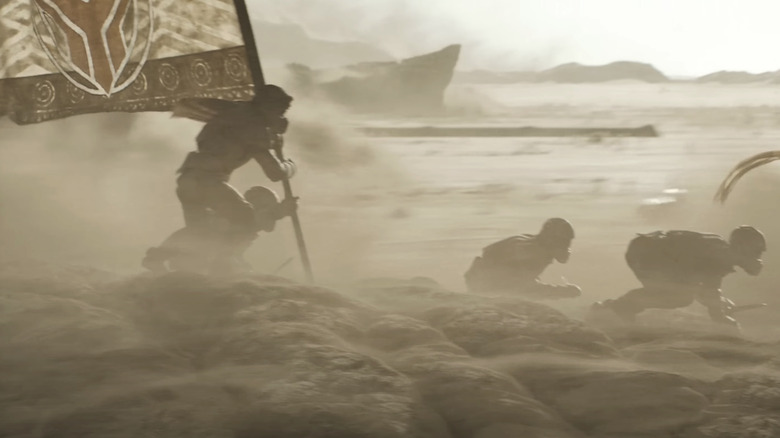Denis Villeneuve's Original Scheduling Ambitions For Dune Would Have Been Brutal
Before Pixar's "Inside Out 2" conquered the global box office, "Dune: Part Two" was the only light amid a truly dismal 2024 for movies. "Part Two" crossed multiple box office milestones on its way to making more than $700 million globally, and that's to say nothing of digital sales. That's impressive not just because almost every other film released in 2024 has struggled to even break the century mark, but because "Part Two" followed 2021's "Dune," which was given a day-and-date release on MAX (formerly HBO Max). As such, there was no guarantee the masses would turn out to see "Part Two" after having been given the opportunity to stream the original film from the comfort of their own homes. But turn out they did, ensuring Denis Villeneuve maintained his standing as a premiere director who can reliably churn out sci-fi blockbusters that succeed both critically and commercially. It also guaranteed that we'd be getting "Dune 3," with Legendary greenlighting the threequel in the wake of "Part Two" dominating the box office.
But a pandemic-hampered release for Villeneuve's initial entry in the franchise was but one of a series of setbacks and challenges for the ambitious "Dune" movies. The two films, both close to three hours apiece, are arguably the French Canadian filmmaker's most ambitious projects, and required a truly frightening level of dedication and focus from the production crew in order to finally come to fruition. However, had Villeneuve stuck to his original plan for making his "Dune" duology, the movies might have never made it to the big screen (or rather the small screen and then the big screen).
Dune and Dune: Part Two were not easy to make
Making "Dune" and "Dune: Part Two" sounds like an ordeal. Denis Villeneueve, cinematographer Greig Fraser, and production designer Patrice Vermette maintained an inhuman level of fastidiousness throughout the making of the films, trudging through the deserts of Jordan and Abu Dhabi in order to find the perfect individual sand dunes for specific scenes, and becoming what Villeneuve termed "sand traumatized" in the process. Surely, though, nobody was as sand traumatized as Vermette, who had to bottle specific sand grains from various places so as to ensure continuity between shooting locations.
Meanwhile, Fraser was busy creating virtual environments of real-life locations, allowing him to track the sun's trajectory in real time and determine the perfect lighting conditions for specific scenes. For Timothée Chalamet and Zendaya's intimate, dune-top conversation, this led to some of the shortest scenes in "Dune: Part Two" taking a full three days to shoot. That's because Fraser identified a solid hour during sunrise for shooting, forcing the crew to trek into the desert for that brief period when filming conditions were ideal.
All of this meticulousness would have been bad enough without the fact that filming conditions on "Dune: Part Two" in particular had people passing out right and left. Put simply, the deserts of Wadi Rum, Jordan, and the Liwa Oasis in the United Arab Emirates were hot as all hell. But even they didn't cause quite as much trouble as a scene shot in Budapest. The Hungarian capital actually experienced temperatures of 110 degrees while during shooting, causing crew members to experience heat stroke.
With that in mind, it's a darn good thing Villeneuve gave up on his initial plan to shoot these epic blockbusters back-to-back.
Dune and its sequel were going to shoot back to back
As per Deadline, "Dune" shot in 2019, with additional footage being filmed the following year. "Dune: Part Two," meanwhile, shot between July and December 2022, giving the cast and crew a decent two-year gap between the films. However, this was not the original plan. Speaking to Entertainment Weekly Denis Villeneuve revealed that he initially envisioned shooting both movies back-to-back, saying:
"Both movies were made in very harsh conditions, and it's very physically taxing, so to have a break in between them was a blessing. My first thought was to shoot both movies back to back together, but now I think I would have died. It was really intense, and seeing how the world reacted to 'Part One' was a boost of positive energy to go back into the desert."
With the theatrical space looking as shaky as it did in 2020 and 2021, it's a good thing Villeneuve didn't film his movies all at once. That would have meant, had the first film not fared well, Legendary and Warner Bros. would have been stuck with a 2-hour 46-minute, $190 million-dollar sequel that nobody wanted to see.
Luckily, people seemed to like "Dune" and very much did want to see "Dune: Part Two," which allowed the studios to greenlight the sequel having given their cast and crew a welcome respite from the punishing heat that menaced production the first-time around. Consequently, "Part Two" gave the box office its biggest boost since last year's "Barbenheimer" mania, proving that even amid the arid, Arrakis-like landscape of 2024's box office, films can still thrive.


